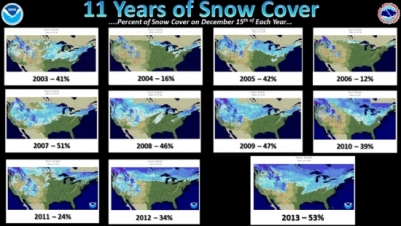12/31/13, "Rescue for Antarctic ice-bound ship under threat," BBC
"A rescue mission for a
ship stuck in ice in Antarctica is under threat as reports have emerged
that one of the assisting vessels may itself be stuck.
However, the Xue Long has barely moved in a day and may be stuck in the ice.
The research vessel Akademik Shokalskiy has been trapped for nearly a week with 74 scientists, tourists and crew.
The ship is stocked with food and is in no danger, the team on board says.
The planned air evacuation required that the two icebreakers in the immediate area - the Xue Long and the Australian Aurora Australis - be positioned close to each other in open water, clear of the pack ice.
However, the captain of the Xue Long has told the Shokalskiy that he is keeping his vessel in a "holding position".
The Aurora Australis, is now understood to be planning to carve through the dense thick pack to assist the Xue Long.
The initial plan had been for a helicopter from the Xue Long to carry people in groups of 15 up from the pack ice next to the Shokalskiy.
The airlifted passengers would then be transferred by a small boat, deployed from the Australian icebreaker, onto the Aurora Australis.
The expedition members would then have travelled to Australia's Antarctic base at Casey some four days' voyage away.
However, if the Chinese vessel is also stuck and the Australian vessel cannot help it reach clear water, there will be no airlift.
Under the initial plan, the remaining crew members would have stayed on board until another, more powerful US icebreaker arrived in up to 10 days' time, the BBC's Andrew Luck-Baker reports from on board the Akademik Shokalskiy.
However, it may now be that all of those on board may have to wait for the US icebreaker, the Polar Star, he adds.
Earlier attempts by Chinese and French icebreakers to reach the ship were also foiled by the thick ice.
The Shokalskiy was trapped on Christmas Eve by thick sheets of ice, driven by strong winds, about 1,500 nautical miles south of Hobart - the capital of the Australian state of Tasmania."
-------------------------------
Reference for US icebreaker traveling from Seattle:
12/30/13, "Antarctic rescue mission fails to reach trapped ship," UK Guardian, Alok Jha
"Another option for rescue lays with the huge American icebreaker, the Polar Star, which is currently en route to the Ross Sea from Seattle. It had been due to travel via Sydney but it has now been ordered to sail directly to its final destination. If it was called upon to assist in the rescue effort, it could get to the sea ice edge near the Shokalskiy in eight or nine days.
There is no fixed timeline for the next steps, said Turney, while the captains of the Shokalskiy, Aurora Australis and the Xue Long waited for good weather. The forecast for the next few days, however, looks like there will be more of the same: snow, wind and heavy cloud.
AAE glaciologists on board the Shokalskiy, meanwhile, have been examining satellite images of the ice build-up over the past week to try and understand why the Shokalskiy got stuck.
"It's remarkable just how much change there's been," said Turney. "The ice that's packed around us is many years old, some is more than 10 years old."
The multi-year sea ice surrounding the Shokalskiy is much thicker and stronger than the new, first-year sea ice because it has had years of snowfall on top and freezing underneath.
According to the satellite maps, this ice was on the east side of the Mertz glacier until this past week, stuck fast to the land. Possibly because of a storm, or some other weather factor, this "fast ice" broke off and was blown into the area in which the Shokalskiy was sailing. Multi-year ice is a lot more difficult to cut through than single-year ice, which was the sort of material the Shokalskiy came through on its way into Antarctica....
The fast ice was partly in the area because of the huge iceberg, B09B. This broke away from the Antarctic continent in 2010, collided with and snapped off the extended part of the Mertz glacier, and then grounded itself in the entrance to Commonwealth Bay. Since then, the sea ice that would normally have formed and blown out to sea has instead been blocked by B09B and frozen into place. Given the recent reorganisation of the ice around the Mertz glacier, glaciologists aboard the Shokalskiy think the ship might have become inadvertently caught in the formation of a new area of fast ice, which could stay in place for several years.
When it got stuck last week, the Shokalskiy was just over two weeks into its month-long journey, from Bluff in New Zealand to Commonwealth Bay in East Antarctica."...
.
.










